In this bi-weekly series reviewing classic science fiction and fantasy books, Alan Brown looks at the front lines and frontiers of the field; books about soldiers and spacers, scientists and engineers, explorers and adventurers. Stories full of what Shakespeare used to refer to as “alarums and excursions”: battles, chases, clashes, and the stuff of excitement.
Arthur C. Clarke’s first published novel—1951’s Sands of Mars—is also one of his most compelling and personal books. It is the story of Martin Gibson, a science fiction writer who has long dreamed about traveling in space, and gets the opportunity to travel to Mars on the trial run of the first interplanetary cruise liner. When he arrives on the planet, he finds not only a frontier full of mystery, but a sense of personal fulfilment and adventure that his life had previously been lacking.
I have remembered this book fondly for years—or at least, I thought I did. I can still see my dad’s paperback copy, featuring two astronauts with cylindrical metal helmets standing in front of a classic streamlined rocket landing on its tail fins beside a dome with antennas on top. I remember a colonist, who may have been brought to Mars involuntarily, struggling to survive on a planet where you couldn’t live for long without an oxygen mask, and the detail that many of the earliest workers on the planet came from mountainous regions of Earth, like the Himalayas and the Andes, and were able to function better in the thin atmosphere.
That paperback of dad’s is long lost, so I ordered the book from my state’s interlibrary loan system. The only copy they had was in an omnibus edition, Prelude to Mars, which included the books Prelude to Space and Sands of Mars as well as 16 short stories. And then, when I finally started reading Sands of Mars, I was shocked to find that I hadn’t ever read this book after all. I must have confused the title with another story about early Mars exploration. So this column is not a re-read, but it is still a review of a book that is well worth visiting, and a classic of the genre. [And if anyone has ideas of other Mars exploration books I might have confused with Sands of Mars, I would be delighted to hear from you in the comments!]
I have visited Mars a number of times in this column. This includes looks at several works featuring the more fanciful planetary romance version of the planet, most notably Edgar Rice Burroughs’ A Princess of Mars, and a number of works by Leigh Brackett, including the adventures of Eric John Stark and the classic novel The Sword of Rhiannon. I also reviewed Ray Bradbury’s The Martian Chronicles, which can be seen as a bridge between the planetary romances and more realistic depictions of the planet. Heinlein’s juvenile adventure Red Planet contained another view of Mars written in roughly the same era as The Sands of Mars. And in Ben Bova’s Mars, I found a more realistic view of visiting the planet, rooted in modern science.
About the Author
Arthur C. Clarke (1917-2008) was a British science fiction writer who spent his final years living in Sri Lanka. He is one of the most influential authors from the formative days of the science fiction genre; with Clarke, Robert Heinlein, and Isaac Asimov often referred to as science fiction’s Big Three. I have discussed Clarke’s work before in this column, having reviewed A Fall of Moondust and Rendezvous With Rama, and you can find more biographical information in both of those reviews. Among his many other books were classics like Against the Fall of Night, Childhood’s End, 2001: A Space Odyssey, and The Fountains of Paradise.
The Great Gap
The Sands of Mars portrays Martin Gibson as a science fiction author who started his career in the days before actual space travel and who gets to travel to Mars later in his life. While specific dates are not mentioned, I would guess that Gibson might have been born in the 1940s, started writing in the 1960s, and travels to Mars in the 1980s or 1990s. In the real world, of course, that progress in spaceflight hasn’t come to pass. Here in 2023, the pioneers of the Golden Age of science fiction field have almost all passed away. And if they were still alive, they wouldn’t be able to get a flight to the Moon, let alone Mars. There were high hopes for space programs after men landed on the Moon on July 20, 1969, and people had visions of moonbases and trips to Mars in the coming decades. But progress is not always linear, and the Apollo program came to an ignominious end in 1972 after only six successful lunar landings. There were a few orbital uses of leftover equipment, including the Skylab program, as well as the eventual launch of the International Space Station, but humans have not left Earth orbit since.
The biggest problem with further manned space efforts was high launch costs: The cost of launching anything into orbit on the single-use, custom-made boosters of the Apollo program was hideously expensive. The US shuttle program was intended to address that with a reusable launch system, but budget limitations and cost overruns hampered it from the start. Instead of being totally reusable, the system ended up with strap-on boosters and fuel tanks that were disposable, and a shuttle with a complex heat shield system that was extremely difficult to maintain.
Part of the problem was focusing on a large vehicle that could perform all missions, including the launch of heavy defense satellites. As someone remarked at the time (I think it might have been Jerry Pournelle), the decision to build such a large craft was like a family buying an 18-wheel truck for daily use, in order to be ready for occasional moves to a new home. The shuttle was tremendously expensive (it cost $54,000 per kilogram launched into orbit), it was not reliable enough for crewed flight, and the shuttle was retired even before its mission of supporting the International Space Station had ended, leaving that task to aging Russian Soyuz craft.
In recent years, however, space launch technology has made major leaps forward. There are several disposable rocket systems that can launch material in space at costs five to ten times cheaper than the shuttle. SpaceX, with boosters that fly back to the launch site for reuse, promises even cheaper costs in the future. And there are other companies also working on reusable launch systems, including those that launch from high-flying aircraft. No one can compete with the cost of an intercontinental aircraft flight (at least not yet), but these innovations have revived hopes of more robust crewed space flight programs in the future, and renewed the hope of bases on other worlds. (See this Wikipedia article for more discussion of launch costs.) After a gap of fifty years, during which meaningful progress in crewed space flight had been minimal, there is renewed hope that the days when a science fiction author can fly to other planets may be in our future after all.
The Sands of Mars
The book opens on a launch pad, as science fiction author Martin Gibson prepares to fly into space for the first time. The pilot teases him about people not passing out from the acceleration of a launch (as they did in his books). Martin, a bit high strung, passes out. And then, despite new drugs that minimize nausea in zero gravity, Martin gets sick in orbit. Gibson resembles the author Clarke to a great degree, and Clarke shows he is ready to poke some fun at himself, here.
Gibson arrives at Space Station One and begins to recover in the artificial gravity produced by its rotation. He sees the dumbbell-shaped ship, Ares, which will transport him to Mars. It is a passenger ship, but he will be the only passenger on this shakedown voyage. The ship is an atomic rocket, which explains its shape, with a crew compartment forward separated by a long, central shaft from the highly radioactive fission plant that heats the reaction mass. It is heavily automated, and has a crew of only six: the captain, Norton; the engineer, Hilton; the navigator, Mckay; the doctor, Scott; the electronics officer, Bradley; and the young supernumerary (on a military ship, he might be referred to as a midshipman), Jimmy Spencer. There are many staterooms that on this trip will be empty. Through Gibson’s eyes, we tour the ship and observe its operations. In fact, in a “meta” moment, one of the officer’s jokes that such tours of the ship are a regular part of Gibson’s books, and Gibson admits that describing a tour is the easiest way for the author to let readers know how things work.
There is a bit of excitement introduced when Earth launches a high-speed cargo rocket carrying an antidote to “Martian fever,” a disease the colonists brought with them from Earth, but which has mutated into a dangerous form. They must contact the missile with a homing signal, and bring it aboard so the doctor can tend to its contents during their voyage.
There is a micrometeorite strike that puts a tiny hole in Gibson’s stateroom, so small that only the instruments detected it. The crew does not want him to find out about it (and alarm potential future passengers by writing about a threat that is vanishingly small), so his previously denied request to go out in a spacesuit gets approved. Designed only for zero gravity, the spacesuits do not have articulated legs, and are more like a tiny personal spacecraft. He has a delightful time, and the crew patches the hole in his stateroom with no one the wiser. There are a few anachronisms that crop up, as communications and navigational equipment is far more primitive in the book than it turned out to be in the real world. Gibson still types manuscripts on paper with carbon copies, and they are transmitted to Earth in a scanner that resembles a facsimile machine. And the spaceship dumps its garbage over the side, as ships did in the days before pollution became a concern, creating what could eventually become tiny hazards to navigation.
Along the way, Gibson gets to know the crewmembers, and finds that he has a surprising personal connection to one of them. Things get a bit “meta” again as the coincidence is described as “an outrageous violation of the laws of probability—the sort of thing that would never have happened in one of Gibson’s own novels.” But it gives Gibson a chance to reevaluate his past, and his life so far, a life that will soon become very different. It turns out that, after a short, failed relationship in college, he has lived his life keeping emotions and commitments at arm’s length.
Ares is diverted to the Martian moon Deimos instead of Phobos, the first indication that Earth authorities are not aware of everything afoot on Mars. There is a description of the planet, as seen from the moon, which matches the best knowledge of the time. For some reason, astronomers thought Mars was without mountains. They also thought the planet had vegetation, as there had been changes in coloration detected as seasons changed. They thought the atmosphere thin and not at all breathable, which turned out to be largely correct, although they underestimated how thin.
Buy the Book
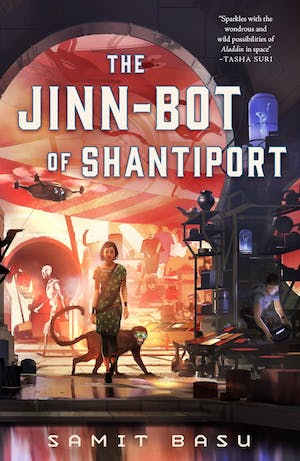

The Jinn Bot of Shantiport
Gibson and the crew fly down on a winged reentry rocket, and when they land, Gibson assumes the large crowd awaiting them has gathered for him, the acclaimed author. But it turns out they are waiting for Doctor Scott and his precious medical supplies, and Gibson, though he immediately understands, is chastened. Gibson meets “Chief” Hadfield, the administrator of the Mars colony, who from the start sees him as someone who can help them sell their efforts to bureaucrats back on Earth, and obtain more resources and funding. Unlike other colonists, Hadfield was allowed to bring a young daughter to the moon with him. Thus, she is about the only person on Mars who is the same age as young Ares crewmember Jimmy Spencer, and unsurprisingly, romance ensues.
The rest of the book involves a series of mysteries and revelations about Mars and its colonists, and I will avoid spoilers by not revealing them all here. Along the way, Gibson begins to identify with the colonists, and starts to feel a sense of belonging that he had previously lacked. He learns more about Martian plant life, and sees there are native plants that can produce oxygen. He goes on a trip to another colony, only to have his aircraft downed by a storm where its jets ingest far too much sand. During their struggle to survive, the crew makes an exciting discovery. And when Gibson returns to the main colony, the secret of the colonial research project on Phobos is revealed, and it is something that will transform the future of the planet Mars itself.
I very much enjoyed Sands of Mars. The prose, as throughout Clarke’s career, is serviceable without being flashy. The characters are realistic, although often thinly drawn. Technological and scientific issues, on the other hand, are addressed with enthusiasm and in great detail. The science is compelling, and there are surprisingly few details that have been overtaken by subsequent technological advances, considering the fact that the book was written over seventy years ago. The big surprise is the level of emotion we find in the character of Martin Gibson, who ends up being a surrogate for Clarke himself. Perhaps Clarke felt he revealed too much, because I don’t recall another of his books where he wore his heart on his sleeve quite so openly.
Final Thoughts
I may not have read Sands of Mars in my youth, but I wish I had. It is exactly the type of book that inspired my lifelong interest in science fiction, and in traveling to other worlds. Some might call the character Martin Gibson a Mary Sue for Arthur Clarke, and see the book as a kind of wish fulfillment, with a science fiction writer living out the dream of seeing other worlds. Personally, it makes me wonder, after long years where hope seemed lost, if some science fiction author living now will get to do exactly that.
And now I turn the floor over to you. I’d love to hear the thoughts of those of you who have read Sands of Mars, and would like to hear about your other favorite tales from the early days of science fiction.










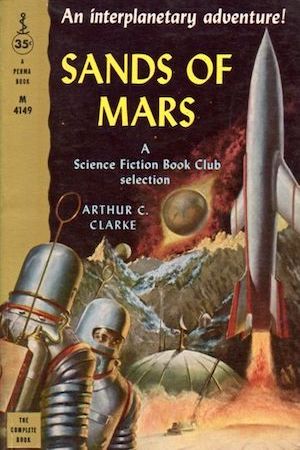

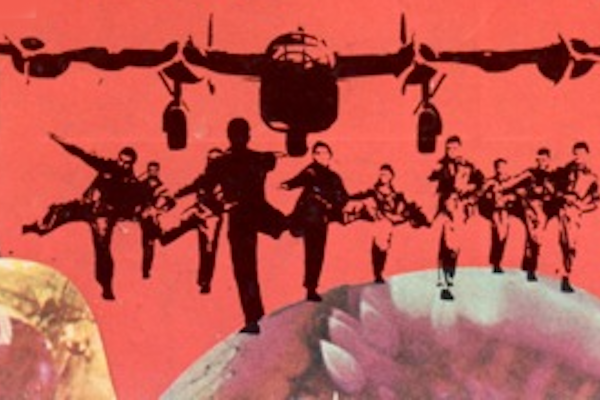
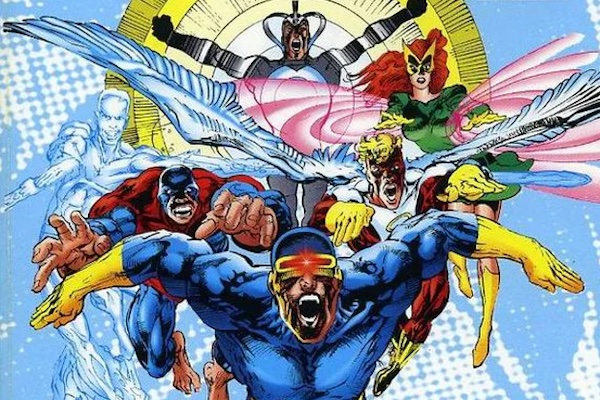
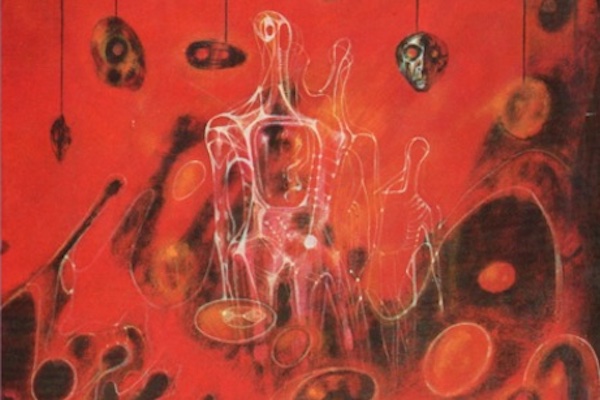
I have a similar memory of confusing this book with another one, but it was another Clarke novel, maybe Prelude to Space. Is that the one where the ship sinks in the Lunar regolith, as it was believed would happen at the time? I think I mixed that up with the “Sands” part.
“The US shuttle program was intended to address that with a reusable launch system, but budget limitations and cost overruns hampered it from the start.”
Or rather, the decision to cut costs and go with the lowest bidder instead of using the best design hampered it from the start. I remember an old science magazine article comparing the various proposed designs and exposing how the ambitions were dialed back to the cheapest, most bare-bones option. I may still have it buried in a drawer along with other Space Shuttle articles I cut out and bundled back in the early years of the program.
“The ship is an atomic rocket, which explains its shape, with a crew compartment forward separated by a long, central shaft from the highly radioactive fission plant that heats the reaction mass.”
The forerunner of the Discovery from 2001! I have the 1983 Signet paperback (which has a 1974 copyright date for some reason), and its Vincent DiFate cover painting makes the ship look a lot like the Discovery, though also a bit like the Searcher from season 2 of Buck Rogers in the 25th Century.
@1 – The Clarke novel you’re thinking about is, I think, 1961’s A Fall of Moondust. The fine, deep dust was restricted to some areas of the lunar maria, and the novel describes a cruise across one that goes wrong.
One of the characters was an Australian Aborigine physicist – his ancestry didn’t come up until near the end, and it was incidental, just mentioned in passing as part of a conversation. An example of how Clarke thought that the future would have got past the blinkered attitudes of his present, even back in 1961.
I reread this just a few months ago! As for the belief that there are no mountains on Mars, I did find this paper from 1908 helpfully explaining why mountains would be impossible on a planet like Mars, but no discussion of what observations had originally established that particular “fact.”
The history of the Shuttle (STS) is complicated, but Pournelle should have known, and admitted, that a major driver of its size and configuration was military requirements.
I’ve thought for years that Clarke was good with settings (except for a tendency to be rather stridently anti-religious in his future worlds) and plots, but, at best, mediocre with characterization, although many of his contemporaries were worse
@2/Raskos: Yes, that’s the one, thanks. Clarke’s first few near-future space-travel novels kind of blur together in my memory. They don’t stand out from each other as much as something like Against the Fall of Night/The City and the Stars or Childhood’s End.
“An example of how Clarke thought that the future would have got past the blinkered attitudes of his present, even back in 1961.”
Kind of the reverse happened, really. When Syfy adapted Childhood’s End into a rather terrible miniseries, they reduced the novel’s biracial lead character, quite progressive for the 1950s, to a supporting role, and turned the supporting character of the UN Secretary-General from the early chapters into a white American farmer who became the lead character, even though they failed to give him a good reason to still be involved in the story after part 1.
For a more modern read on Mars colonization try John Barnes’ The Sky So Big and Black.
@2
“The Clarke novel you’re thinking about is, I think, 1961’s A Fall of Moondust. The fine, deep dust was restricted to some areas of the lunar maria, and the novel describes a cruise across one that goes wrong.
One of the characters was an Australian Aborigine physicist – his ancestry didn’t come up until near the end, and it was incidental, just mentioned in passing as part of a conversation.”
Reminds me about how the reader doesn’t find out that Juan Rico in Heinlein’s STARSHIP TROOPERS is Filipino until near the end of the book. It always annoyed me that his ancestry has been ignored in all of the cinematic adaptations of the novel that I have seen.
@5- Yes Clarke’s near future space stories do kind of run together in my memory also but I still have love for them. I first read The Sands of Mars back in the early 70’s as part of a box set that had 2001: A Space Odyssey, A Fall of Moondust, The Lost Worlds of 2001, and the short story collection The Nine Billion Names of God. Did you have to bring up SyFy’s Childhood’s End? I will never understand how so many awful changes were made from the novel.
The Mars colonization story you’re thinking of, with reluctant indentures from the Andes and Himalayas is Crucifixus Etiam, by Walter Miller Jr.
Martin Gibson is high strung?
Anyone have any idea why Clarke used the names of the two leading guitar makers of the time as his character’s name? Also high strung is Nashville tuning where you use just the high strings from a 12 string guitar set. Great if unintentional pun.
According to UK astronomer Patrick Moore’s foreward to the Puffin edition of Clarke’s Islands in the Sky:
I might suggest that this was Arthur C Clarke attempting to write a literary novel with a SF setting, the emphasis being on character and day-to-day life rather than space battles etc. Thus its as much about the people on the colony and the spaceship as about the mechanics and science of maintaining such a colony. I am not enough of a SF historian to wonder if the sub-plot about interplanetary politics and economics was pretty new at the time. I doesn’t (imho) quite work and at times tips into bathos but is still a fun read and one of my favourite Clarke’s.
Like OP and others above, I did not finally get to read this until the ’90s and only knew about it because of the reference in the Islands in the Sky foreward. I assume Clarke either put some pressure to keep it out of print, or did not complain overly when his publishers did so. The edition I’ve got is obviously tied in with the success of 2001 and so I assume was printed to cash in on that film’s success.
@1 I also thought of Discovery when reading the description of Ares.
@3 Thanks for that info on the “flat Mars” theory.
@9 I will look for the story you mentioned. Thanks.
@10 I totally missed the guitar connection!
@11 Perhaps Clarke felt the story was too personal. Myself, I thought the character stuff added a warmth to the book that Clarke’s other work often lacked.
@12
Agree totally. I always get the impression that he regretted publishing it. Perhaps he got some very nasty feedback and criticism about it. Parts of the dialogue are embarrassingly bad. But an interesting experiment all the same and I’m glad it’s more easily available that it used to be.
I was lucky enough to read *The Sands of Mars* in my youth. Along with his other interplanetary space books like *Prelude to Space*, *Islands in the Sky* plus the short stories set in nearer futures with commonplace space travel. Then later *A Fall of Moondust* which is still one of my favourite Clarke novels.
A dumbbell-shaped nuclear powered spacecraft was effectively a consensus notion for that type of space travel. *Sands* was probably written in the early nineteen-fifties, when people were optimistic about how fast space travel might progress. They were obviously thinking about how quickly aviation developed and assumed spaceflight would follow the same path.
The guitar connection seems improbable. Clarke was British and guitars wouldn’t have made that amount of impact in 1950s Britain.
There are echoes of ideas Clarke used in later books. For example, a line can be drawn between *Sands* and *2010: Odyssey Two* about what happens to Phobos. The book is of its time. Then it was credible that Mars had an almost breathable atmosphere, the presence of plants and a flat, no-mountain terrain. Typewriters and vacuum tubes were credible technologies for the future. Solid state electronics was barely out of the laboratory. Yes it is dated, but it can be read as a product of its time. Clarke may have been taking the mickey about making Gibson a science-fiction writer similar to himself. That is to say, poking fun at himself. Something he was done several times. “I Remember Babylon”, for one.
This column inspires me to drag out my copy of the book. I feel a re-read is well overdue. Thank you, Alan, for refreshing my memories of this novel.
I’d say he definitely was, given that Gibson’s best-known title was “Martian Dust!”
Yes, this book has a bit more of the human touch than most of Clarke’s stuff. I’ve been trying to think of other Clarke novels which do, and the best examples I can find are The Deep Range and The Songs of Distant Earth.
Re-reading Sands of Mars right now, and couldn’t help but notice this exchange in Chapter 4—
“Meteors are considerably less dangerous than lightning and the biggest normal one is a lot smaller than a pea.”
“But, after all, one ship has been damaged by them!”
“You mean the Star Queen? One serious accident in the last five years is quite a satisfactory record. No ship has ever actually been lost through meteors.”
Clarke, Arthur C.. The Sands of Mars (p. 45). RosettaBooks. Kindle Edition.
Clarke’s story “Breaking Strain” (1949) tells the story of a Star Queen that had been holed by a meteor. And it is mentioned in The Collected Stories of Arthur C. Clarke, that—
Originally published in Thrilling Wonder Stories under the title ‘Thirty Seconds—Thirty Days’, ‘Breaking Strain’ was one of the stories incorporated into the film and novel, 2001.
Clarke, Arthur C.. The Collected Stories of Arthur C. Clarke (p. 169). RosettaBooks. Kindle Edition.
So we have another reference to 2001, along with the similar description of the Ares & Discovery. I thought that the legless Are’s spacesuits with articulated arms resembled the space pods from 2001 too.